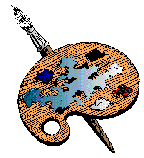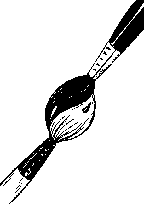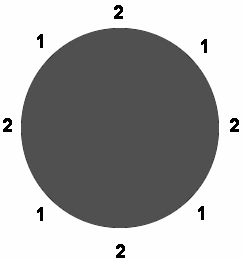




| ARCHETYPE | ATTRIBUTE | ELABORATION |
 |
Be a good listener | Hear what people are saying |
| Be empathetic and understanding | Be responsive to poeoples' feelings | |
| Develop and maintain a trusting relationship | If people can confide in you, it will make your job easier | |
| Be accepting and uncritical | Take in all information, positive and negative, without being judgemental | |
 |
Satisfy your audience | Make every effort to meet the needs of your clients |
| Keep options open - be flexible | Don't get stuck in one way of thinking or with only a few alternatives | |
| Be prepared | Be ready for anything | |
| Motivate with humor | People will learn more if they are comfortable and having fun | |
 |
Develop a variety of solutions | Use models as a launch platform to develop multiple possible answers |
| Develop creative solutions | Don't just do it, do it with style | |
| Deal with ill-structured problems | Be prepared to make senese of confusing situations | |
| Turn the basic into the unique | Take what you are given and make it something special | |
 |
Develop a strategy | Determine what steps need to be taken |
| Use analysis skills | Like an auto-mechanic, first find out what's broken. | |
| Fix the problem, not the symptoms | Make sure to get to the root of the problem | |
| Be effective and efficient | Do what needs to be done using the fewest possible resources | |
 |
Obtain multiple perspectives | Get input from a wide variety of people |
| Test designs early and often | Don't wait until the last minute to see if it will work | |
| Use diverse evaluation methods | Conduct one-to-one, small group, and large group feedback sessions | |
| Determine the contextual factors | Find out what the environmental influences are, including setting and climate |
There are two rounds in each game and players are separated into two teams. Players seat themselves at the table, with players from opposite teams alternating seats. See diagram below for example of 8 player game with two teams.

Round 1
- During Round #1, the five Archetype
cards are spaced out evenly on the table.
- A player from team 1 begins by
randomly choosing one of the cards from the shuffled Attribute stack
(the elaboration cards are not used until round 2).
- The card is then read aloud (but
not shown) to the player to her left. This player can then choose
to match the Attribute card to the appropriate Archetype
card, or pass. If the player chooses the correct Archetype card (correct
match), then that player's team is awarded 1 point. If the player
chooses incorrectly, her team loses one point. It is important that
after each incorrect guess that the reader not place the card on the correct
Archetype, as other players have a chance during that turn to attempt to
match the card after it is answered incorrectly. In the case of an incorrect
guess, the next player to the left (who is on the opposite team)
can then choose to attempt to match the card, or pass. This process
continues until the card is matched, or all players have passed.
At the end of the turn the card should be placed with the correct Archetype,
either by a correct match or everyone passing.
- Play continues in a clockwise
fashion (regardless of passes, correct, or incorrect answers, the reader
will be the person to the left of the reader in the previous turn.
- Play continues until all Attribute
cards have been played.
- Points for Round #1 are as follows:
1 point for each correct Archetype and Attribute match; -1
points for each incorrect Archetype guess; and 0 points for a pass.
Round 2
- Play during round #2 is identical
to round number #1, except the Elaboration cards are matched to
the Attribute cards. In round 1, the there were only 5 choices
(the five Archetype cards). In round 2, there are 20 choices
(each Elaboration card corresponds with one of the Attribute
cards placed on the table in round #1).
- The point system is somewhat
different as well, as there are two possible ways to make a correct match:
1) The player attempts to match the Elaboration card to the correct
Attribute
card. If the match is exact, the player's team is awarded 2 points.
It is also possible, however, that the player choses an to match the Elaboration
card to an Attribute card that is not exactly correct, yet they
have chosen the correct Archetype category. In this case the
card is placed on the correct Attribute, and the player's team is awarded
1 point. If the player guesses completely wrong (wrong Atribute;
wrong Archetype); that player's team loses one point, and play continues
to the left until a correct match is made, or all players pass.
-The team with the most points
at the end of round 2 is the winner, however, the instructor should have
a class goal of all teams finishing with positive point totals.
Post-Game Activity
Have each of the players select
one attribute of an instructional designer that they taken the role of.
Have them describe what they did whe wearing this "hat" in an online discusssion
forum. They should then read and respond to other students' anecdotes
as well. Discuss the anecdotes during the second class session.
**New** Click here
to try out a prototype of the online version of the game. When playing
the game, the card should be covered with a peice of paper of 'sticky',
and read by the opposite team. In this way the players attempting
to match cards will not simply match the icons. Keep in mind, this
is just a prototype.
COUNSELOR -
BE A GOOD LISTENER
A co-worker's cousin was hit by
a car. He was only 14 years old. She did not understand why this had to
happen to him. So at this point all I could do was be a good listener.
COUNSELOR - DEVELOP AND MAINTAIN
A TRUSTING RELATIONSHIP
I organized the American Heart
Association Heart and Stroke Support Group at the Potsdam Hospital and
was the Director for 9 years. It was a wonderful but demanding experience.
I had to develop and maintain a trusting relationship with the many heart
and stroke patients who attended the meetings. I became a very good empathetic
and understanding listnering. The long hours were very rewarding, I feel
they gave more to me than I did them. I regretfully gave up the position
because besides working fulltime, I wanted to pursue my College education,
while also caring for my mom who I finally lost to cancer on July 3, 2000.
COUNSELOR -
BE ACCEPTING AND UNCRITICAL
Often times in the scanerio of
diet ed. goals are estiblished but not obtained. In order to continue to
move the patient ahead one must be accepting and uncritical.
COUNSELOR - BE ACCEPTING
AND UNCRITICAL
This is one of my responsibilities
as an assistant hockey coach to the head coach Mark Morris. He comes under
enough criticism, concerning the decisions he makes, from the public so
I need to be supportive and ultimately a friend.
PERFORMER - MOTIVATE WITH
HUMOR
As the dairy princess I to teach
children about the benefits of milk and dairy products. To do this I had
to come up with fun games and funny skits to keep their interest and make
sure they got the point.
PERFORMER - 1) BE PREPARED;
2) KEEP OPTIONS OPEN - BE FLEXIBLE
I think I am a performer, with
the music background I have always believed deep inside that I need to
be prepared all the time. I need to perform at my best as a student, as
a daughter, as any roles I take. I also believed we need to keep the options
open and be flexible all the time, not to be paranoid, but what if something
you spend all the energy and time to work on and it didn't work out?
Everyone needs some alternative plans. So when something doesn't work we
have plan B, C, D, E, etc.
PERFORMER - BE PREPARED
Being prepared to adapt our plans,
on the spot basically, is very important as a teacher (especially this
time of year). Each and every class is different. I teach four sections
of Regents Earth Science, each of them is very different from the rest.
Another twist, this time of the year, is school delays. We may have shortened
classes, but still must find ways to get through the same amount of material
effectively.
PERFORMER - BE PREPARED
I am currently the Varsity Swimming
coach at Indian River High School. Each day I am challenged to motivate
15 swimmers who have individual goals and needs at the same time. It takes
careful planning to meet each swimmers needs. If I am not prepared
with a detailed practice plan these swimmers would lose interest fast.
PERFORMER - BE PREPARED;
COUNSELOR
- BE ACCEPTING AND UNCRITICAL
This reminded me of my role in
performance improvement. When unexpected things happen, they are
reported to my office. Our role is to be uncritical, yet be prepared
to reduce the risk of recurrence of the event.
PERFORMER - SATISFY THE AUDIENCE
I taught Latch-Key, an after school
program for elementary level students, for two year's. Keeping the
80+ students attention was the Key to my success or failure. I was the
only teacher. What I did or did not do determined everything. I was responsible
for all of those students for up 3 and an half hours. To maintain the peace
and the attention of each and ever student I had to "satisfy the audience".
Whatever it took I did it, acting out hip characters of the time, Playing
indoor and outdoor activities(playing not just supervising), and knowing
what interests each student had and when to point them in that direction.
In fact come to think of it, this Anecdote includes Problem
Solving,Counseling,
Artist,
and the Performer models. If
you don't believe me stop by your local school around 3:00 in the arfternoon,
and enjoy the structured chaos.
ARTIST - DEVELOP CREATIVE
SOLUTIONS
After graduating from The Crane
School of Music last December, I took on a professional residency in Arts
Administration with the Community Performance Series. I spent much of my
residency as a Designer as Artist-Develop Creative Solutions. When
I arrived at CPS, the Meet the Arts! Outreach Program was a shambles. I
developed an entire program to facilitate outreach performances and activities,
including scheduling performances, cultivating new venues, increasing artist
rosters, administering artist payroll and evaluating outreach programs.
As a result of my creative solutions, the outreach program increased audiences
by at least 50%. Needless to say, I am quite proud of the students, community
members and myself for our achievements!
ARTIST - TURN THE BASIC INTO
THE UNIQUE - TAKE WHAT YOU ARE GIVEN AND MAKE IT SOMETHING SPECIAL.
Over the past years since undergraduate
school, I have worked as a school band director at a small rural school.
Each year with experienced students graduating, and newer inexperienced
students coming into the program. Every year there would be changes in
the strengths and weaknesses of the different sections. And every year
I would have to utilize the resources I had, and adapt my planning and
selection of materials in order to get the best performance from the group.
ARTIST - DEVELOP A VARIETY
OF SOLUTIONS
I teach sixth grade math. I always
try to show a variety of solutions for my students because there are so
many different learning styles. Also NYS standards promote a variety of
solutions.
PROBLEM SOLVER - FIX THE
PROBLEM, NOT THE SYMPTOMS - MAKE SURE TO GET TO THE ROOT OF THE PROBLEM
Much time and effort is lost if the wrong thing is fixed. The easiest fix
does not always address the ROOT of the problem. I am reminded of a project
whereby the ER time was thought to be too long in treating patients. A
team was formed and it was decided that lab work was not getting to the
Lab fast enough, an expensive pneumatic tube system was purchased and when
remonitored, the times of treatment were even longer. The team was lead
by assumptions, not by facts, and misidentified the root cause.
This page created 6/13/01 by Anthony Betrus. Last updated 6/21/01.